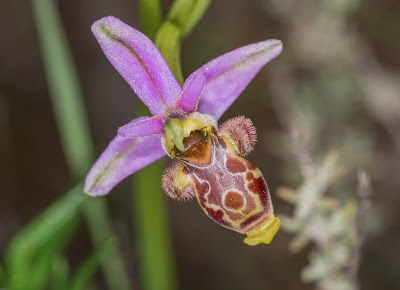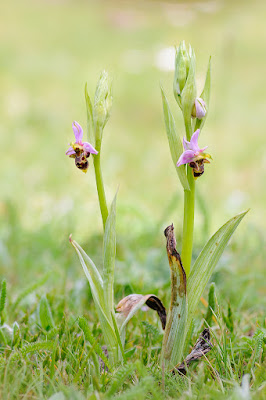Ophrys scolopax, also called as Woodcock orchid is found growing in dry as well as moist soil in full sunlight to light shade area of roadside slopes.
Ophrys scolopax, also called as Woodcock orchid, Ophrys fuciflora subsp. scolopax, Ophrys holosericea subsp. scolopax, is a species of the genus Ophrys. This species was described by Antonio José Cavanilles in 1793.
IDENTIFY OPHRYS SCOLOPAX - WOODCOCK ORCHID
Ophrys scolopax is native to Hungary, Mediterranean to Northern Iran. It is found growing in dry as well as moist soil in full sunlight to light shade area of roadside slopes, garrigue, open pine and oak woods, grassland and olive groves in Albania, Algeria, Baleares, Bulgaria, Corse, East Aegean Is., France, Greece, Hungary, Iran, Italy, Kriti, Krym, Lebanon-Syria, Morocco, North Caucasus, Portugal, Romania, Sicilia, Spain, Transcaucasus, Tunisia, Turkey, Turkey-in-Europe, Yugoslavia at elevations of 0-2000 meters above sea level.
It is a small to medium sized, cold growing terrestrial orchid which reaching 10-90 cm in height with round tuber and ereact stem. The leaves are 5 to 6, lanceolate to oblong-lanceolate, typically start to appear above ground in late autumn and are often beginning to yellow by the time the flowers appear.
Woodcock orchid blooms in spring on a 37.5 cm long, 2 to 21 flowered inflorescence. Each flower has the standard structure for the genus. The sepals are violet to white or green. The petals are violet to rose-coloured or green. The lip has a complex three-dimensional shape and is strongly patterned and is with (reddish) brown to dark brown ground colour.
OPHRYS SCOLOPAX - WOODCOCK ORCHID CARE AND CULTURE
Cultural information should only be used as a guide, and should be to be adapted to suit you. Your physical location; where you grow your plants, how much time you have to devote to their care, and many other factors, will need to be taken into account. Only then can you decide on the cultural methods that best suit you and your plants.
Light:
Ophrys scolopax receive direct morning sun in autumn in their natural habitat. As the season progresses and grasses and shrubs leaf out, the plant receive less direct sun, more dappled shade. So it is best to grow the plant in spring in direct sunlight in an eastern exposure, and once the sun progresses more directly overhead in summer, provide more shade. Once the leaves have died back in late spring, you can even put them in a shed or other protected area because they are dormant during the summer. In colder areas, the plant need to be brought indoors during the winter months and placed on a windowsill or table near a window where they will still be exposed to the winter light levels, but not to close to the window where it could get too cold.
Humidity:
Woodcock orchid needs the humidity level of 40-60%. Too dry air has a negative effect on the development of the plant: its growth is inhibited, and the leaves begin to turn yellow and dry out. The higher temperature, the higher the humidity should be, and the higher the humidity, the more often and longer it is necessary to ventilate the room where the plants are contained, otherwise the probability of rotting and various kinds of fungal diseases. Good air movement is essential while the plants are in leaf and growing.
Temperature:
Ophrys scolopax will tolerate the typical temperatures from -2 to 28°C providing they are given protection from frosts in winter. Ideally they should be grown in a shade-house or protected verandah position where they are protected from frosts and direct summer sun.
Substrate and growing media:
Ophrys scolopax grow in alkaline soils, often colonising areas of disturbed soil particularly those left after building works. The plant can be successfully grown in a greenhouse or coldframe in either terracotta or plastic pots with 80% perlite, pumice or expanded clay, 20% organic components as substrate. Plants to be grown in small terracotta pots should be put into a trough of sand to ensure the tuber keeps cool and to enable watering via the sand rather than onto the rosettes. Plants in plastic pots can be sat on capillary matting which should be kept wet. Check the dampness of the pot by assessing the weight of the pot. Water the matting if the pots feel light.
The plant should be repotted in early autumn soon after the leaves have died back at the end of May. Do not delay repotting as the pseudobulbs shoot below the surface in early winter and the new shoots are easily broken during repotting. They do not like being disturbed and may not flower well for the first year after repotting. They should only be repotted after they have filled the pot or the potting mix needs replacing.
Watering:
The sand should be kept damp. As the plant begins to grow increase the watering of the sand until the tuber compost is slightly damp during the autumn growing period and again when the flower spike grows. Once the leaves have died down in autumn they should not be watered for the next 4-6 weeks and allowed to rest dry to avoid rotting the bulbs.
Fertilizer:
Woodcock orchid doesnt need fertiliser. Many experts claim that the use of any fertilizer would ruin the natural growth of this orchid, which only needs to have humus and moisture enriched soil to thrive and flower at the right time.
Rest period:
During the mid winter period watering can be stopped. Stop fertilization in late autumn . When the new leaves have appeared in late winter watering can be resumed but only sparingly for the first few weeks as roots do not develop until about 4 weeks after the shoots appear. The surround air temperature should not be allowed to get too high and provide maximum ventilation throughout the autumn and winter. This is particularly important with the species that grow where the winters are dry and cold. Do not allow the pots to get hot and cold in mid winter.















COMMENTS